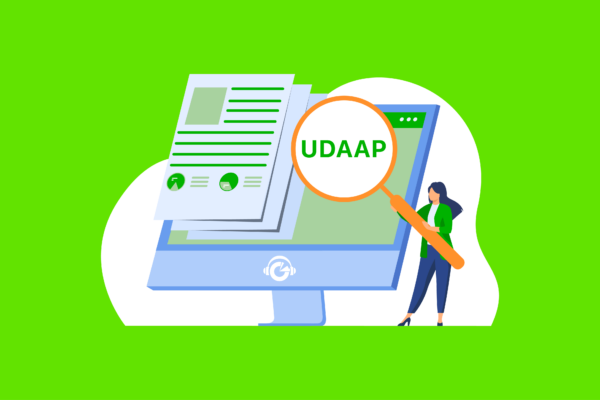Episode Description:
This COMPLY Podcast episode is part two of a discussion between experts at PerformLine as they continue to talk through the top marketing compliance issues thus far in 2022 which we’ve uncovered using the PeformLine platform. Topics include:
- The multiple compliance concerns with using language like “fast approval” or “instant approval” on marketing materials
- Avoiding black-box models for decision-making and preventing ECOA compliance issues
- Best practices for compliance monitoring and consumer protection across marketing channels and partners
Show Notes:
- 2022 Top Marketing Compliance Issues Report: https://bit.ly/3y3ETE3
- The Top Marketing Compliance Issues and How to Avoid Them Webinar: https://bit.ly/3xFGfEF
- Follow Rhonda: https://www.linkedin.com/in/rhonda-mcgill/
- Follow Gianna: https://www.linkedin.com/in/gianna-barrere/
Subscribe to COMPLY: The Marketing Compliance Podcast
About COMPLY: The Marketing Compliance Podcast
The state of marketing compliance and regulation is evolving faster than ever, especially for those in the consumer finance space. On the COMPLY podcast, we sit down with the biggest names in marketing, compliance, regulations, and innovation as they share their playbooks to help you take your compliance practice to the next level.
Episode Transcript:
Ashley:
Hey there COMPLY podcast listeners! Today’s podcast is part two of a discussion between experts at PerformLine as they continue to talk through the top marketing compliance issues thus far in 2022 which we’ve uncovered using the PeformLine platform. Topics include; the multiple compliance concerns with using language like “fast approval” or “instant approval” on marketing materials, avoiding black-box models for decision-making and preventing ECOA compliance issues, and best practices for compliance monitoring and consumer protection across marketing channels and partners. Thanks for listening and enjoy the show!
Gianna:
Another takeaway from this report is around the use of terms like instant or fast approvals. So again, can you both kind of talk about why these terms are so often flagged and why organizations should be cautious when using such terms?
Rhonda:
Yeah, I think, and Sarah probably could speak to this more because she looks at rules every day <laugh>, so she, she’s in the hot pot on a regular, on a regular basis. But I think it’s kind of similar to the discussion we just had about the interpretation of a consumer and just how everybody has that. You know, people want things now, you know, they want it instant, They want, everybody wants instant, but what is instant? You know, what does that mean when you’re trying to buy a house and you have to move in 30 days? What does that mean when you don’t have food on your table? So the instant can mean several of things. So it’s just being able to, you know, make sure that when you’re saying instant, where you’re saying fast, when, say anything that kind of raises that level of urgency or, you know, Expedia that we’re, that, that the, you know, you have to make sure that you’re being responsible with it, and that’s where the disclosures come into play. So, yeah, I, I’m gonna definitely turn it to Sarah because I’m sure that she has a lot of thoughts on this because she sees these terms on a regular basis.
Sarah:
Absolutely. And again, very, very valid points, Rhonda. As you mentioned, everything today is, you know, you want it now, and sometimes the only difference between consumers, whether it be for a financial product or an item or whatever it is some people make their decision based off of who can get them the result the fastest. So while again, we’re, we’re all, you know, guilty of doing that to some extent, I’m sure nowadays, but when it comes to, again, a consumer’s financial wellbeing, you really can’t, you know, just carefully put that language out there anymore. You do need to be very cautious for a couple different reasons. So, number one, as you mentioned the term instant and immediate things like that are buzzwords, especially in today’s world. And so sometimes people can get caught up in the difference between, you know, when they say, Okay, you can get an instant loan that’s not always the same as receiving the capital instantly.
Sarah:
That might mean, you know, from the moment that you’re approved, their team is going to start working on getting you that loan immediately. But I’d say it’s pretty seldom that you will actually receive the funds right away. And so even though that does not happen very often, the claims stating that that would happen very often are all over the place. And so of course one thing to be mindful of is when you’re putting, you know, time, even those rough timelines out there subject to interpretation, you most likely will want or need to have a disclosure there so that people aren’t expecting to get things, you know, within minutes when realistically it might take them a business day or so. Another thing that is probably the more serious violation when it comes to the instant or immediate approval language is just that the implication of being approved.
Sarah:
I’ve seen just from my own personal experience, very, very few, companies are able to actually offer a true instant approval. You know, most of them, I’d say are perhaps not most, but a decent amount nowadays might offer instant decisioning. So you might know within moments of submitting your application, if you will be accepted, depending upon the algorithm or whatever formula that goes into that decision might be indicating. But again, when you’re telling consumers, Hey, click here for immediate approval, or, Hey, get an instant preapproval here for your mortgage, some people will be taking that at face value. They might be trapped into applying things, applying for things that they ultimately cannot afford. And again, similar to a few minutes ago, you can kind of wind up harming them in many more ways than what was intended when in reality some of your merchants, partners, affiliates might just be trying to close the loop.
Sarah:
So I’d say increasing the awareness here is extremely important. And again, you know, we have a very flexible rulebook. So over, over time, especially over the past few years, we’ve been placing more of an emphasis on pre-qualification. You know, I’d say each company probably has their own sensitivity levels when it comes to, you know, implications of being prequalified. So some companies might say, you know, if if somebody were to use the phrase, Get prequalified right now, that may or may not be an issue. But if you have, you know, a, a partner out there saying, Hey, fill in your information, get pre-qualified instantly and move on in the process, that can be a bigger issue. Okay. So I’d say initially while we were just looking at language centered around approvals, nowadays it’s become much more common for people to seek out these pre-qualifications. So we have of course added that type of verbiage to our rule books and we’ll continue to add things as, as we see them begin to trend more. But definitely one of the, the somewhat more recent things to, to be cautious of.
Rhonda:
Absolutely. And just, just, you know, adding on to that a little bit more too, just as you hear more and more like CFPB as they’re talking more about, you know, black box models for making lending decisions and how that impacts the consumer and making sure that, you know, you’re not teetering yourself into potential ECOA violation and you don’t wanna be seen as a company that is discriminating against someone. So it’s a lot of responsibility that it comes with claims. And so it’s just making sure that as you are putting together your advertisement, whether it, you know, whether regardless of what space you’re putting it out in, but just making sure that you’re aware of how that can be ingested by the consumer and that you’re doing all of the right things to protect them or provide them with the additional information. And if for some reason they’re not given that loan product or whatever that you’re able to explain to them, not just tell them that, that the machine told you, you know, but you have to be able to explain to them and potentially explain to a regulator how that decision, credit decision was made and make sure that it didn’t fall into a potential ECOA issue.
Gianna:
Thank you both so much. Before we wrap it up, cuz we’re kind of getting to the end of our time here, I just wanted to ask each of you what you found most surprising from the report or what you thought the most impactful takeaway was? I can start. I was surprised to see that offer inflation and incentivization accounted for 50% of all remediations under UDAAP. So terms like discount, the best free savings and this kind of falls back under that like subjective language that we had talked about earlier and substantiating those claims. But, you know, these types of promises might be true for some consumers, but they definitely won’t be for all. So using these terms without disclosures or clarification definitely has the potential to harm a consumer who might not know any better and will just take these claims at face value. So the takeaway here for me is that if you’re gonna make a claim that a product or service is the best, or that I can offer x amount of savings or something of that nature, I would make it a best practice to just make sure that these claims are followed by some sort of substantiation or disclaimer, clarifying, you know, the statement or the claim that you’re making.
Rhonda:
I think you said it perfectly. I was, you know, I was giving that some thought and I was like, Wow, what, what would be the one thing that was the surprise for me? I would say, you know, a lot of it is not a surprise as much as it is opportunity to really, really go back at it with, you know, that it’s time to take another look at your rules, make sure that you’ve got the right rules in place that you’re set up, you know, setting yourself up, your business up for success. You’re setting your clients up for success. And that’s something that, you know, we can always do along with you, but we have really worked really hard to train and make our rule books very flexible and to try to raise up these types of observations to give the opportunity for our clients to really go back in and say, Okay, these are the most remediated terms, are we utilizing those and should we take a look at those for a little while to see what it surfaces for our business?
Rhonda:
This is also, you know, I think we’re in a weird time again, I can’t say that enough. We’re in a time where things are ebbing and flowing and they’re shifting and there’s a lot of folks that are in that desperate desperation mode to bring, you know, the business and, you know, interest rates, thankfully, hopefully are gonna continue to trend down a little bit, but we don’t know what we don’t know. And so it’s, this is all opportunity, but I would say that my biggest takeaway is it is important to pay attention to these types of these types of updates because this is really an opportunity from a business perspective to make sure that you don’t get caught into a trick bag that could land you in a bad spot with a regulator.
Rhonda:
And we can’t guarantee you that you’re not gonna have regulators knocking at your door, but you can at least be able to take a little bit of confidence in saying that you have a process in place through monitoring, regardless of if it’s your call center, your web, your social, whatever it is, even in our documents channel, you know, we have our paid social, so we’ve got so many opportunities to really dive in and help your business to, you know, thrive through constant change. And so I would just hope that one of the, you know, the takeaway for me is to continue to work hard on our rules and to make sure that we’re perfecting and paying attention to the data and that we’re sharing information like formats like this with our clients so that they can be the best possible versions of themselves that they can be during turbulent times.
Sarah:
Yeah, very much agree with everything Rhonda just pointed out. You know, it’s a, it’s a changing world nowadays, so it’s important to keep your eyes open, stay vigilant, and just increase your awareness in, in any way that you can. And so in terms of something that I personally found the most, surprising and, and something that had the most impact for myself, I was trying to, you know, think over all of this data that we’ve been analyzing and, you know, I’ve, I’ve been here several years and something that has just been very consistent and very prevalent pretty much everywhere and every area that I’ve overlapped with, comes back to these payday loans claims. So when you think about it industry by industry, it’s probably not very surprising that there are these fraudulent, sometimes suspicious websites, making these claims without our clients permission about their ability to facilitate or acquire these payday loans.
Sarah:
However, you know, we often find very often find examples of these that we will go through, especially with our trainings. And so from time and time again, we have seen clients shocked when they see their business in writing on a sometimes very nice professional presentable looking website that is linking them to these payday loans when they might have nothing to do with that space. And so again, time and time again, we find examples of that everywhere. And I have been on so many training calls where, you know, typically there might be a few of the clients on that training call where they, they might even stop the, the training quickly to have some back and forth with each other and they might say, Oh my goodness, can you email, like, can you send this to us, from this training? We need to email this to so and so and they need to get on this right now, or, you know, we need to have that investigated today.
Sarah:
So that the sense of urgency has just been so consistent. Again, it kind of makes sense when you think about it. It might not be the most surprising how much these claims are out there, but I, it seems like many companies are understandably in the mindset of, oh, we’re nowhere near that space. So no one would try to, you know, pull some brand infringement and claim that we’re affiliated with them. I will, don’t, don’t always, you know, operate under that assumption because time and time again, it has shocked people to see their websites on here. So for myself, it was almost that intersection of nobody thinks it’ll happen to them. And yet again, numerous, numerous clients, this is an extremely common issue that we’re seeing across the board. So just that sense of kind of surprise and then, you know, gladness that we’re able to, to step in and help them proactively monitor that.
Sarah:
Again, as Rhonda mentioned before, we certainly want to help them take that additional step to be prepared, help protect the consumers, even if they’re not, you know, that business’ clients at that point, but just do our part to, to help preserve consumer financial health while also protecting the reputation and the standing of our clients. So I’d say definitely keep an, keep an eye out for those alerts. They’re very common and again, we’re able to improve over time and add more language to help find additional creative instances of this happening. So, that would probably be my strongest takeaway from this.
Gianna:
Awesome. Thank you both so much. I think this has been super insightful and I really hope our audience, you know, is leaving with some really solid takeaways today.
Ashley:
Thanks for listening to this episode of the COMPLY podcast! We hope you enjoyed the conversation between these PerformLine experts around the top marketing compliance issues we’ve seen thus far in 2022. To get the full report on Top Marketing Compliance Issues, be sure to check out today’s show notes and as always for the latest content on all things marketing compliance you can head to content.performline.com.




